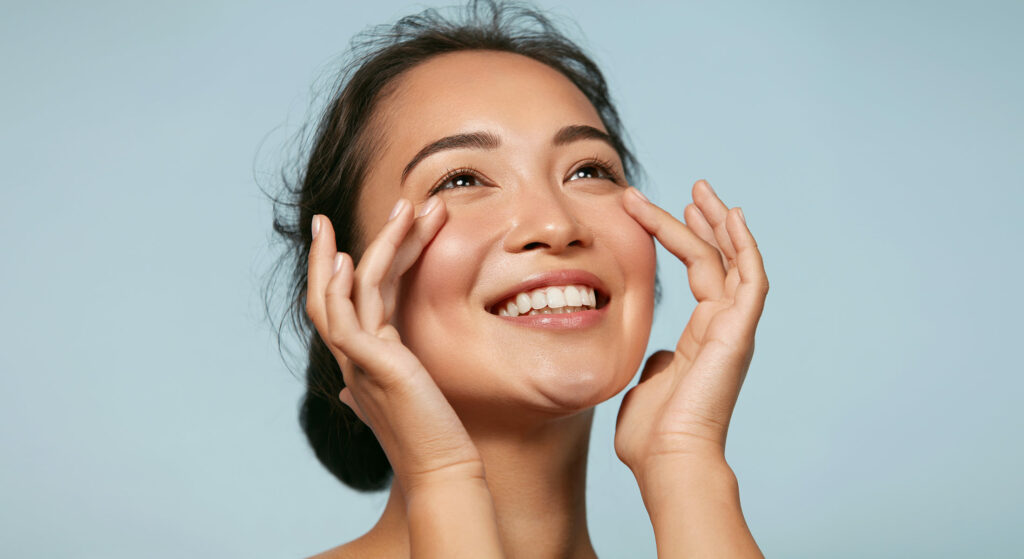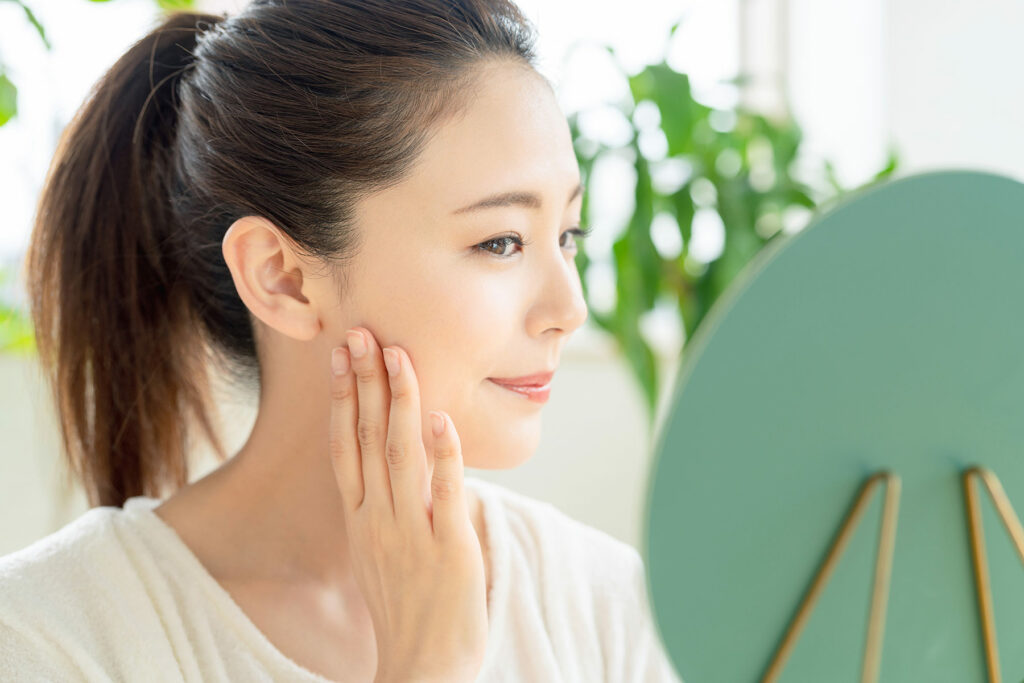
Asian Eyelid Surgery (Blepharoplasty)
Blepharoplasty is the most commonly performed facial cosmetic procedure in both men and women. This popularity is bolstered by the demand for eyelid surgery from the East Asian population. Many people of East Asian descent are born without creased eyelids, and have epicanthal folds that they find make their eyes look small, tired, or angry. People of East Asian ancestry are also more prone to eyelid ptosis (droopy eyelids), both congenital and acquired, which can make for sleepy-looking eyes and, in some extreme cases, impair vision. Though these characteristics are not exclusive to people of East Asian descent, this is where they are found quite commonly. East Asian patients frequently seek out this type of procedure, so called “Double Eyelid Surgery,” making it necessary for an entire branch of blepharoplasty devoted to Asian eyes.
Patients with these physical characteristics often desire enhancement to the eyelid in order to create a more awake, approachable, lively appearance. This can be as subtle as a crease made to the eyelid or a more drastic removal of excess skin. The intention of these procedures is not to make the eyes appear more caucasian or “western” but rather to enhance the natural crease and fold that is commonly seen in Asian anatomy. As matter of fact, at least 50% of Asian descent have naturally occuring “double eyelid”.
Monolids
The lack of or a poorly defined crease in the upper eyelid, referred to as a “single eyelid” or “monolid,” is found most commonly in people of East Asian ancestry. Many people find that this lack of definition results in their eyes appearing smaller, angry, or tired and some complain of a “heaviness” in the eyelid. In some cases, those with a very defined medial epicanthal fold may find that their eyelashes are pushed downward, sometimes irritating the eyes and obscuring vision. It is also not uncommon for some people to have a natural asymmetry in the eyes, perhaps having one monolid and one double. To modify these characteristics, some will opt to have double eyelid surgery, also known as Asian blepharoplasty.

Blepharoplasty (Double Eyelid)
Asian Blepharoplasty is a cosmetic surgery performed on the upper eyelid to create a crease where there was not one previously. To achieve this, a monolid is divided into two parts–which is where it gets the name “double eyelid”–creating a natural fold and crease that is commonly seen in Asian anatomy, resulting in wider, more open eyes. The actual crease configuration has many options, in terms of crease height and shape. For example, the inner aspect of the crease can be either tapered into the natural epicanthal fold, so called “infold,” or it can be a more parallel configuration, or “outfold.”
What to expect during Asian Blepharoplasty
Prior to your appointment, a consultation is required so that Dr Amadi can examine your unique anatomy, learn your desired results and discuss with you your options. There are two main methods of Double Eyelid Surgery, and many subtle shape preferences so a detailed consultation is necessary to determine which one is right for you.
The Incisional Technique is done by making a small incision across the upper eyelid, parallel to the lashline; a small amount of skin is then removed where the crease will be. Depending on the individual anatomy of the patient and the desired results, excess muscle and/or fat may also be removed. After this, the eyelid muscles will be attached to the dermal layer of skin which will create a natural crease.
The Suture Technique (or non-incisional) is performed by putting sutures through small punctures created along the eyelid. The sutures, simulating the natural attachments in the eyelid, are then tightened until the desired crease is achieved.
Both the incisional and suture technique require local and short-term surface anaesthesia and depending on which technique you opt for, the procedure usually takes between 30 mins for suture and up to an hour for incisional.
Incisional vs suture
Incisional:
- 40-60 minutes to complete
- Done under local & short term surface anaesthesia
- Initial healing: 1-2 weeks downtime with moderate swelling and bruising
- Small, easily concealed scar along incision line
- May take several months to heal completely
- Results will be visible within two weeks and will continue to develop for several months
- Permanent results
Suture Technique:
- 30 mins to complete
- Done under local & short term surface anaesthesia
- Healing time: 5-10 days with mild bruising and swelling
- No scarring
- Results visible immediately and more accurately in 5-10 days
- Patients can usually return to regular activity within 48 hours
- Results last 5-10 years
Though the list above may make it sound like the suture technique would be the better choice, the incisional technique is actually the more popular of the two. This is mainly because of the permanence of the incisional technique. With the “Suture Method,” although the sutures are permanently inserted into the eyelid, over time, the results will fade, sometimes sutures break and the results are less reliable. You can expect the results from suture blepharoplasty to last anywhere from 5 to 10 years. The main draw for the Suture technique is the lack of a scar and the quicker recovery with earlier final results.
One major drawback of the suture technique is that not everyone is a candidate. If you happen to have eyelid ptosis, redundant skin or excessive fat, then the suture method is not for you.
Combined procedures
The incisional method provides lifelong results and it can also be combined with other procedures such as medial epicanthoplasty (a complicated surgery done to release or partially release and excise the medial epicanthal fold, a fold of excess skin present in the inner corner of the eyes) and ptosis repair. The necessity of these procedures will be explored during your consultation.

What to expect during recovery
With the Suture Technique, you can expect the swelling to subside significantly within two to three days. This can be helped with the application of ice packs and you may take over-the-counter painkillers if necessary. Results will begin to be noticeable when the swelling subsides with the final outcome visible within two weeks.
The Incisional Technique has a significantly longer recovery period. Your incision will be closed with stitches that will be removed by your physician at your post-op appointment, one week after your surgery. There is also significantly more bruising and swelling involved in the recovery from this method of blepharoplasty. Ice packs will help with these symptoms and they will subside significantly within two weeks, at which point you can begin to apply makeup to camouflage any residual discoloration. Swelling may take up to six months to suside completely. Your results will be visible within two weeks and will continue to develop over several months.
It is important to remember that initially, due to swelling, your crease will appear higher than where it will sit naturally once the inflammation subsides.

Risks and Complications
Probably the biggest risk of blepharoplasty is that of asymmetry. Though uncommon, this is usually very slight and subsides over time. If you are unhappy with the results of your surgery, you may be a candidate for revisional surgery.
The other risks specific to blepharoplasty are difficulty closing the eyes, dry eye, irritation, damaged eye muscles, double or blurred vision, and loss of vision, though these are rare.
As with any cosmetic procedure, it is of the utmost importance to find a reputable, experienced doctor to perform your blepharoplasty, so that you can achieve your most desired results with the least risk of complication. A consultation is required so that both you and your surgeon can get to know each other and discuss your options and set realistic, achievable goals.
Revision Double Eyelid Surgery
If you are unhappy with the results of a previous blepharoplasty, or perhaps your results have faded, you’ve come to the right place! Revisional blepharoplasty is notoriously more challenging than primary blepharoplasty. This is because these often require additional fat grafting to create the most natural results. Dr. Amadi is a highly skilled Oculofacial Plastic Surgeon with over 19 years of experience performing blepharoplasty and he is sought out by people across the country to perform revisional surgeries – Dr. Amadi has a reputation of being able to rectify even the most difficult cases.
A renowned Asian Blepharoplasty specialist
For these procedures to be performed properly, it is necessary to find a cosmetic surgeon with advanced knowledge and understanding of Asian anatomy, specifically the eyes. Dr. Amadi has extensive experience performing Asian blepharoplasty. He has published research on the subject and has travelled overseas to South Korea to train and master his skill with internationally renowned Asian Eyelid Surgery Specialists. With his skills, and ability to listen to his patients’ wishes, you can rest assured that you are in the most capable hands. Dr. Amadi will do everything to ensure that you achieve your most desired outcome.
Book a consultation with Dr. Amadi to discuss your options for primary or revisional surgery and what he can do to help you achieve your most optimum results. Learn more here!
Amadi Plastic Surgery
Lorem ipsum dolor sit amet, consectetur adipiscing elit. In nec erat in nibh pellentesque vestibulum eget eu massa. Lorem ipsum dolor sit amet,